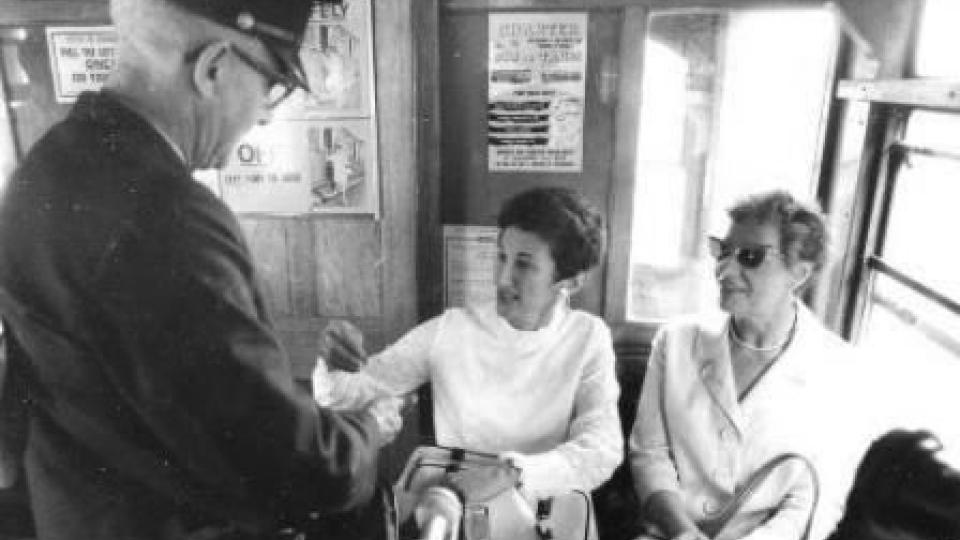Zelda D'Aprano and the ongoing fight for equal pay

Communist and feminist Zelda D’Aprano became the symbol of the fight for equal pay when, in October 1969, she chained herself to the Commonwealth Offices in Melbourne, after becoming frustrated at the lack of pay equity for women.
D’Aprano was employed by the meatworkers union, which was involved in a test case on the gender pay gap in the meat industry before the Commonwealth Conciliation and Arbitration Commission. At the time, women’s participation in the workforce was 38% and they were paid 75% of men’s wages for doing the same work.
Years later, D’Aprano explained how she felt in the Commission hearing: “I just couldn’t believe this. I thought, here are all the women, here we are, all sitting here as if we haven’t got a brain in our bloody heads, as if we're incapable of speaking for ourselves on how much we think we’re worth. And here are all these men arguing about how much we’re worth and all men are going to make the decision.”
The Commission’s judgement handed down in June 1969, adopted the principle of “equal pay for equal” work, to be phased in over three years, bringing women covered by federally registered awards into line with those covered by state awards.
But the decision had limited application, as few women were doing the same work as men. Three years later, fewer than 20% of women in the workforce had actually received equal pay.
D’Aprano explained the impact: “Once again, the vast majority of women were deprived of wage justice and the private sector retained its source of cheap labour… A feeling of dejection and what can we do now, prevailed.”
D’Aprano decided to take action: “I thought about it and I thought, well something's got to happen. Someone’s got to do something ... [and] I was prepared to chain myself up.”
The event drew enormous public attention to the equal pay campaign, and led to the establishment of the Women’s Action Committee (WAC) in Victoria in 1970. WAC’s campaigns for equal pay included women paying only 75% of the fares on public transport.
Continued campaigning for equal pay by the women’s movement nationally finally forced the newly-elected Gough Whitlam government to refer the matter back to the Conciliation and Arbitration Commission in 1972, where the principle of “equal pay for work of equal value” was adopted.
However, turning the “principle” of equal pay for work of equal value into an actual economic and social reality for women is still unfinished business.
Employers and anti-worker governments have sought to undermine equal pay at every opportunity. The gender pay gap actually widened following the election of the John Howard government in 1996.
Today, the full-time average weekly ordinary earnings for women are 15.3% less than for men. The gender pay gap is much worse in the private sector, ranging from 17.3% (base salary) to 22.4% (total remuneration). This difference, compounded by the time women require off for maternity leave and caring for children, accumulates over a woman’s working life. As a result today women have an average 42% less in superannuation balances than men on retirement.
Australia still has a highly sex-segregated workforce. Women are concentrated in health care and social service professions. This contributes to the lack of equal pay and will only change with pressure from a mass movement of women and their allies.
The (Un)Fair Work Commission decided in February to deny equal pay for early childhood educators, who earn as little as $21 an hour. This followed the federal government’s failure to deliver funding for equal pay by the February 1 deadline set by United Voice, the workers’ union. This has triggered the biggest walk off of early childhood educators Australia has ever seen. A nationwide stoppage will take place on March 27, as part of the Big Steps campaign.
The Australian Services Union’s campaign for equal pay, which achieved pay rises of 19–41% for 150,000 mostly female workers in the social and community services sector in 2012 was an important victory and shows what can be achieved with a coordinated industrial and community campaign.
The struggle by women and their allies for equal pay continues and should be at the forefront of the fight for wage justice and against the profits-first agenda of the super rich, the corporations and any government that protects their interests.
In the so-called “post feminism” ideology of the 1980s and ’90s — in reality part of neoliberal capitalism’s backlash against the gains of second wave feminism — women were told we had achieved our liberation, or worse, that we had gone too far!
We were told through the media, or via liberal feminist academics and commentators that realising our liberation now was about individual choices, lifestyle or culture jamming.
Meanwhile, equal pay was still elusive for working women and many of the programs designed to promote women working in non-traditional workplaces were being slowly dismantled, along with welfare programs, free education, universal healthcare and public housing.
This backlash came as the second wave movement ebbed and sections of the trade union movement were coopted under the Hawke Labor government’s Accord. The attacks on militant unions, such as the Builders Labourers Federation, further weakened the fight-back.
Today, more than ever, we need a class-based feminism so that we can build the alliances needed to fight sexism and misogyny, and to challenge the power and profits of the 1%.
[Zelda D'Aprano died on February 21, 2018. Susan Price is a national co-convener of the Socialist Alliance. See our Gender Agenda here.]